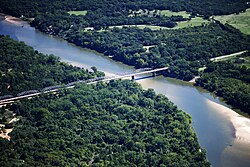
A truss bridge is a bridge whose load-bearing superstructure is composed of a truss, a structure of connected elements, usually forming triangular units. The connected elements may be stressed from tension, compression, or sometimes both in response to dynamic loads. The basic types of truss bridges shown in this article have simple designs which could be easily analyzed by 19th and early 20th-century engineers. A truss bridge is economical to construct because it uses materials efficiently.
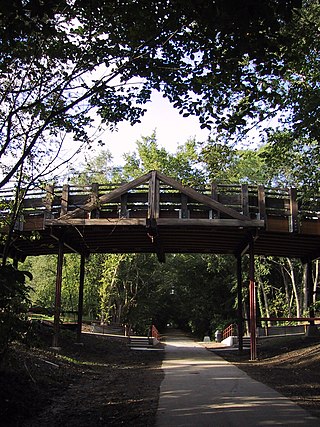
The Camelback Bridge is a restored historic wooden bridge that arches over the Constitution Trail in Normal, Illinois. It is on the U.S. National Register of Historic Places. The bridge's main span is a wooden kingpost pony truss. The bridge is supported by Phoenix columns, a type of wrought iron column that was patented by the Phoenix Iron Company in 1862. It is one of only two bridges in Illinois using the columns.

The Wanette–Byars Bridge is a long bridge in central Oklahoma. It crosses the Canadian River between Byars in McClain County and Wanette in Pottawatomie County. The bridge is on a county road, not a state-designated highway.
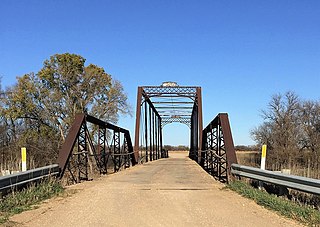
Pott's Ford Bridge is a bridge 1/2 mile south of Glasco, Kansas, USA that spans the Solomon River in Cloud County, Kansas. It has a wooden deck with three bowstring pony trusses and one Pratt pony truss. The lengths of the trusses are 48 feet (15 m), 46 feet (14 m), and 149 feet (45 m) for the bowstring trusses, and 72 feet (22 m) for the Pratt truss. It was built in 1884 by the Wrought Iron Bridge Company of Canton, Ohio.

The Golden Hill Bridge is a historic bridge on Golden Hill Road over the Housatonic River in Lee, Massachusetts. It is a lenticular pony truss bridge built c. 1885 by the Berlin Iron Bridge Company, and is the state's oldest surviving bridge of this type. It is one of only five Berlin Co. bridges in the Berkshires, and is the only known surviving bridge to implement modifications to the pony truss design patented by William O. Douglas in 1885. The bridge was listed on the National Register of Historic Places in 1994.

The Gateway Trail Iron Bridge is a historic camelback truss bridge on the Gateway State Trail in Stillwater Township, Minnesota, United States. The bridge has stood in three locations in Minnesota. Its main span was built of wrought iron in 1873—before steel became the preferred material for metal bridges—and erected in Sauk Centre in Central Minnesota. Designated Bridge No. 5721, it was refurbished and moved in 1937 to rural Koochiching County in northern Minnesota, where it became known as the Silverdale Bridge. It was relocated to its present site in east-central Minnesota in 2011 and renamed Bridge No. 82524. It was listed on the National Register of Historic Places in 1998 for its state-level significance in engineering. It was nominated as a rare example of a wrought iron truss bridge with ornamental detailing.

The Lilley Road—Lower Rouge River Bridge is an automotive bridge located on Lilley Road over the Lower River Rouge in Canton, Michigan. It was listed on the National Register of Historic Places in 2000.

The Waltz Road–Huron River Bridge is an automobile bridge located on Waltz Road spanning the Huron River in Huron Township, Michigan. It was listed on the National Register of Historic Places in 2000.
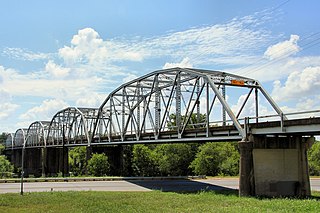
The Montopolis Bridge is a historic Parker through truss bridge in Austin, Texas. It is located in the Montopolis neighborhood where a bicycle and pedestrian walkway crosses the Colorado River in southeastern Travis County. The bridge consists of five 200-foot Parker through truss spans and four 52-foot steel I-beam approach spans resting on reinforced concrete abutments. It was added to the National Register of Historic Places on October 10, 1996.
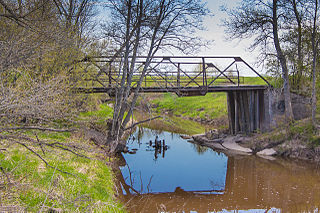
The Parker Road–Charlotte River Bridge, also known as the 10 Mile Road–Charlotte River Bridge, is a bridge building located on Parker Road over the Charlotte River in Bruce Township, Michigan. It was listed on the National Register of Historic Places in 2000.

The Cameron Suspension Bridge crosses the Little Colorado River at Cameron, Arizona, United States.

The US 12–St. Joseph River Bridge is a three-span camelback bridge in Mottville, Michigan, that carried U.S. Route 12 across the St. Joseph River. Built in 1922, it is the fourth bridge to cross the river at this location. It has served as a pedestrian bridge since 1990 when a new bridge opened alongside to carry the highway. The bridge is the longest surviving camelback bridge in Michigan. It is a Michigan State Historic Site and is listed on the National Register of Historic Places.
Four historic bridges on the Big Thompson River in Larimer County, Colorado survived its flood of 1976, but since have lost most of their historic integrity. They were built in 1933 and 1937. All four were listed on the National Register of Historic Places in 2002, and two were delisted in 2010.

The Deep River Camelback Truss Bridge is a steel camelback truss resting on stone and concrete piers, with a macadam road surface covering a plank deck.
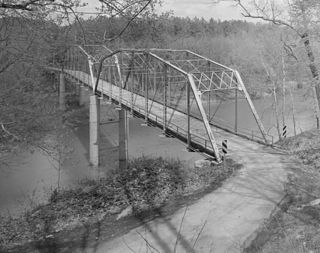
Clarkton Bridge was a historic Pratt truss bridge located over the Staunton River near Nathalie, in Charlotte County, Virginia. It was built in 1902 by the Virginia Bridge & Iron Co., and was the only remaining metal truss structure in Virginia built for highway purposes, which was supported by steel cylinder piers. It consisted of two camelback, pin-connected steel through truss channel spans, and twelve steel deck beam approach spans. The overall dimensions of the bridge approach and truss spans were as follows: north approach, 370 feet (110 m) with twelve deck spans; north truss, 150 feet (46 m); south truss, 150 feet (46 m). The total length of the bridge was 692 feet (211 m).

The State Highway 79 Bridge at the Red River was a bridge carrying Texas State Highway 79 and Oklahoma State Highway 79 over the Red River at the Texas-Oklahoma state line. The camelback pony truss bridge was 2,255 feet (687 m) long and had 21 truss spans. The Texas and Oklahoma highway departments built the bridge as a combined project in 1939. The bridge provided a direct route between Waurika, Oklahoma and Byers and Wichita Falls in Texas. The bridge was the only camelback pony truss bridge remaining on a Texas state highway and the fourth-longest truss bridge in the Texas state highway system prior to being demolished.

The Lover's Lane Bridge is a historic bridge spanning the Dog River in Berlin, Vermont. Built in 1915, it is a rare early 20th-century example of a Warren pony truss bridge. It was listed on the National Register of Historic Places in 2006 as Bridge No. 27.

The Crystal Springs Street–Dowagiac River Bridge is a road bridge that carries Crystal Springs Street over the Dowagiac River near Sumnerville, Michigan. It was installed in that location in 2017. Between 1938 and 2016, the bridge was located approximately 50 miles away, and carried M-86 over the Prairie River near Nottawa, Michigan, and was known then as the M-86–Prairie River Bridge. The bridge was listed on the National Register of Historic Places in 2000, and is the last remaining camelback pony truss bridge used on the state trunkline system in Michigan.

The Gillespie Dam Bridge is a through truss bridge spanning the Gila River in Maricopa County, in the U.S. state of Arizona. The bridge was constructed to bypass a concrete apron through the river in front of the Gillespie Dam, which was often closed due to flooding. Construction of the bridge started in 1925 and completed in 1927. From its opening until 1956, the bridge was part of U.S. Route 80 (US 80), a transcontinental highway between San Diego, California and Tybee Island, Georgia. The bridge was restored in 2012 by Maricopa County for the Arizona Centennial and now includes an educational interpretive center for visitors. The bridge became part of Historic US 80 in 2018.

The Gugel Bridge, also known as the Beyer Road – Cass River Bridge, is a bridge carrying Beyer Road over the Cass River in Frankenmuth Township, Michigan. It was listed on the National Register of Historic Places in 2000. It is the only remaining example in Michigan of a bridge with both a pony truss span and a main through truss span.
